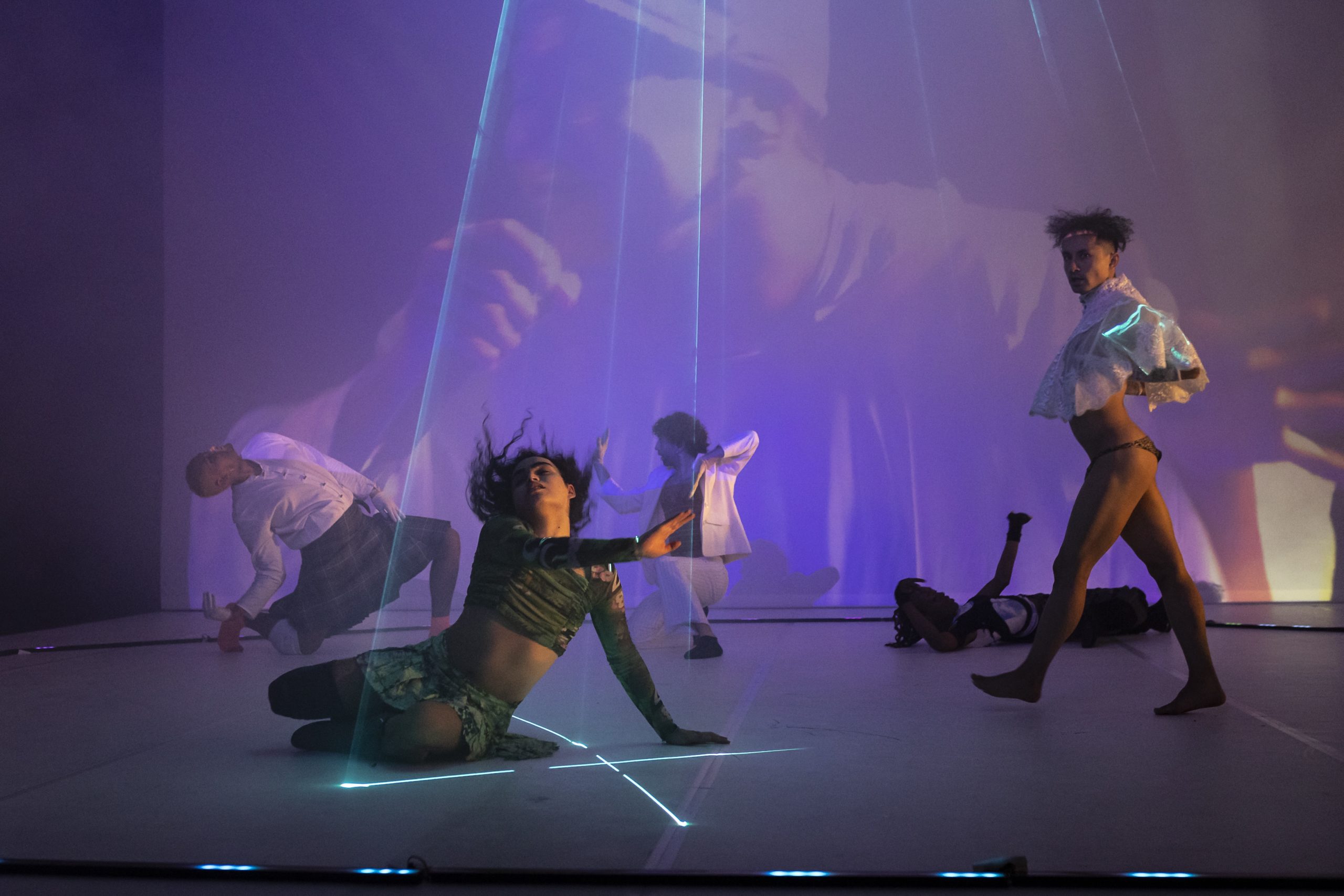Words by Qiao Lin Tan. Qiao is one of the 12 Guest Writers who participated in our 8-week writers development programme supported by Arts Council England.
It’s not everyday you watch a performance that changes your perception of your country, but Yishun is Burning by Berlin-based Singaporean artist Choy Ka Fai did exactly that. The show eludes easy categorisation – it’s part-film documentary, part-ritual, part-ballroom, part-live stream. There’s motion capture and incense, there’s voguing and ritual and vestiges of Bharatanatyam and Chinese dance.
Before any dancing takes place, performer Sun Phitthaya Phaefuang (also known as Aurora Sun LaBeija) humbly kneels in front of an Indian altar table, then parades solemnly in a circle around the performance space with a garland of flowers. Before long, the scent of a Chinese incense stick wafts across the space and I am instantly brought back to Singapore and afternoons spent at Buddhist temples. As a Singaporean, the country’s CMIO (Chinese, Malay, Indian, Other) racial model makes such ethnic incongruences instantly noticeable. This collision of different cultures and religions in Choy’s work is purposeful – the research is based on a spirit medium from the Singaporean town of Yishun, who worships both the Chinese goddess Guanyin and Indian goddess Kali. Filmed footage of a visit to a Hindu festival in 2019 and interviews with the medium herself form whole sections of the piece.
The title is, of course, a reference to the seminal Paris is Burning documentary on queer ballroom culture. However, instead of New York, it is Yishun that is on fire, a Singaporean town infamous for strange incidents in recent years – murders, suicides, cat killings and apparently a rat problem.
It’s the dumpster fire of Singapore – Another news headline? Oh, of course it’s Yishun again. In Choy’s work, however, Yishun transforms into a stronghold for queerness and resistance against the categorising, capitalist logic of Singapore. A foil to pristine and sanitised images of Singapore, Yishun is located in the heartlands, where the rhythm is different and the colours are warm.
In Choy’s work, Yishun, for all its news headlines, is the epitome of the Singaporean melting pot described by authorities. The work is filled with trans-culturalisms – Chinese people at an Indian religious festival, Malay musicians dressed up as Chinese deities of the underworld, and death drops at a Hindu ritual. The Singaporean pledge of “one united people regardless of race, language or religion” comes true through such ‘incongruences’ and queerings of clear ethnic and religious boundaries.
Like Yishun and the medium that channels both Guanyin and Kali, Sun’s dancing moves effortlessly between dance cultures, from Bharatanatyam footwork and hand gestures, to Chinese dance postures, and to duckwalks, dips, and hand performances from voguing. In Choy’s work, the body is shifting, porous and evades easy identification.
Sun dances across physical and digital spaces: through motion tracking technology, his body is projected behind him onto the back wall of the theatre as the Indian goddess Kali, with her necklace of skulls, swinging tongue and multiple blue arms. Kali/Sun enters into an almost trance-like state – tongue out, bouncing, legs circling as Sun is splayed out on the floor in ecstasy. There is a thin line between religion and sexuality, but whether it is fasting, ceremonial piercing, meditation, abstinence or gyrating in a club, the sensations of blood, skin and muscle are brought to the fore.
Accompanied by pulsing electronic beats from Chinese drummer Cheryl Ong and Malay music duo NADA (who were streaming in live from Singapore!), the ritualistic atmosphere easily transforms into that of a drag ball. Sun is soon joined by an additional four dancers from the local vogue scene in London, who dance to the electronic tune of Cascada’s “Everytime We Touch” set to Malay lyrics that are blasted onto screens like a karaoke. By the end of the song, The Place is screaming and whooping. Sun, sweaty and slightly out of breath, thanks the audience and introduces each dancer to cheers. He then addresses the audience, “We still have one more performance left for you. Do you wanna see it?” “Yes!” “Do! You! Wanna! See! It!” “YES!” The stage darkens as “ENCORE” appears on the screens, eliciting a laugh. The Place partakes in one last voguing party for the night to a remix of a traditional Malay song. In a homage to Sun’s own fluctuating identity of being Thai-Norwegian, Sun appears in a traditional Thai crown and a European lace shawl, strutting down the catwalk to raucous cheers.
I’ve never thought of Singapore as a particularly queer city, but the queering of Singapore through Choy’s work made me rethink my impressions of Singapore, sparking a renewed sense of wonder for my home country. At the heart of this work is trans-ness – ideas of the trans-national, trans-racial, trans-cultural, trans-gender, trans-worldly. The body is porous and transverses across categories of race and gender and space and time; it does not adhere to the regulated, systematised logic of Singapore’s CMIO racial model, or the organisation of religion across such racial lines. Yishun is Burning is a purifying act, a burning away of categorical identities, replacing it with bodies and souls in space connected through this ritual performance in this moment.
